Milk is something you probably don’t spend too much time thinking about. When you walk through the dairy aisle in your local grocery store, you likely just grab the jug or carton you’ve always bought and rarely think twice.
But when you really stop and look around a bit more, you’ll be astounded at the wide variety of milks you can choose from.
1%, 2%, whole milk, skim, lactose-free, rice milk, soy milk, coconut milk, goat’s milk, almond milk, even hemp milk. So many choices.
And every option has its benefits and its dangers, though some are surely better for you overall, right?
I decided to find out. So, let’s talk about which milk you should actually buy? And how are you supposed to know which is the superior option for your health?
What Kinds Of Milk Are There?
Cow’s Milk
 When you think of milk, the first image that pops into your mind is probably the bleach-white kind celebrities used to drink from a tall glass before proudly displaying a white mustache.
When you think of milk, the first image that pops into your mind is probably the bleach-white kind celebrities used to drink from a tall glass before proudly displaying a white mustache.
That kind of milk is dairy milk, from cows. It comes in several varieties, including whole milk, reduced-fat (2%), and low-fat (1%). Those percentages refer to how much fat is in the milk by weight.
Regular cow’s milk contains around 150 calories per serving, 8 grams of protein, 5 grams of saturated fat, and 12 grams of sugar. It’s also high in calcium and vitamin D.
This milk used to be pretty standard. It was tough to find any other options than this kind from the cow – extracted from the mammary glands, heavily processed, and shipped across the country.
When you look even farther back, you’ll find a milk that was a different color, texture, and taste – one that had nowhere near the shelf-life of today’s product. You can still find that kind of milk today, but it’s pretty hard to get your hands on due to so many government regulations that have been set on dairy.
The problem with “raw milk” is that it hasn’t been pasteurized. Pasteurization is a process where 161 degree heat is applied to every particle in milk to kill bacteria. If this wasn’t done, we’d run into pathogens like E. coli and listeria on a far more regular basis.
Some promote this as a benefit, saying the bacteria found before the pasteurization process are actually good for the gut. However, most experts agree the negatives outweigh the benefits. Maybe that’s why raw milk is banned in so many states.
2 percent milk still has around 3 grams of saturated fat, 120 calories, 8 grams of protein, and 12 grams of sugar. Less calories and fat, same protein and calcium content.
1 percent or skim milk has 102 calories, 2 grams of saturated fat, 13 grams of sugar, 8 grams of protein, and the equivalent calcium and vitamin D content.
Now let’s look at the other choices.
Lactose-Free Milk
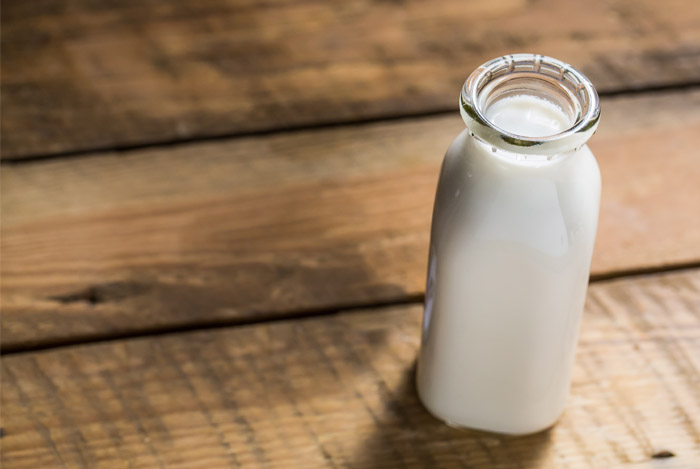 The reason why it’s so tough for people with lactose intolerance to digest regular milk is because their stomachs lack the enzyme lactase. Lactase helps by breaking down the milk sugars that cause the often devastating gastrointestinal issues lactose intolerant folks are so familiar with.
The reason why it’s so tough for people with lactose intolerance to digest regular milk is because their stomachs lack the enzyme lactase. Lactase helps by breaking down the milk sugars that cause the often devastating gastrointestinal issues lactose intolerant folks are so familiar with.
While the label “lactose-free” is often applied to non-dairy milks, here I’m talking specifically about the dairy kind with lactase added.
Lactose-free milk contains far fewer grams of saturated fat (1.5 grams) than regular milk. At 110 calories, 8 grams of protein, 12 grams of sugar, and a comparable calcium content, lactose free-milk is a slightly healthier option for people who can’t handle traditional dairy.
Soy Milk
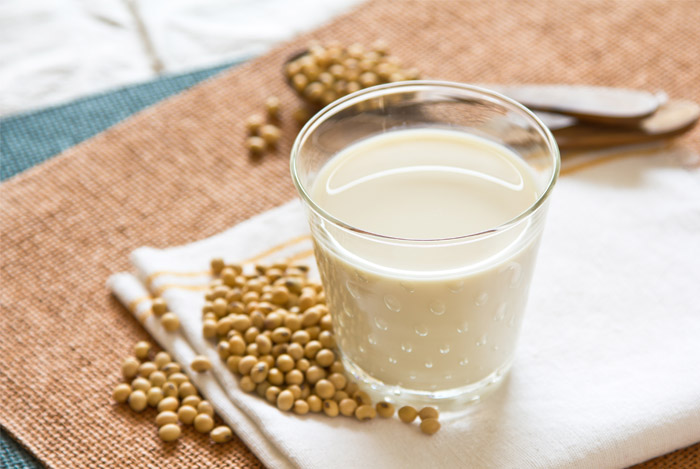 Soy milk was developed in large part due to people who have milk intolerance or allergy. There are some very popular brands of soy milk alongside traditional dairy, and many people enjoy it even if they aren’t restricted from drinking the dairy kind.
Soy milk was developed in large part due to people who have milk intolerance or allergy. There are some very popular brands of soy milk alongside traditional dairy, and many people enjoy it even if they aren’t restricted from drinking the dairy kind.
Soy itself is heart healthy, and the amount of protein found inside the original soy milk is the same as what’s found in dairy milk: 8 grams, with 110 calories.
Soy milk is often sweetened with added sugars (6 grams). For people watching their sugar intake there is an unsweetened variety. Protein in unsweetened soy milk is usually around 7 grams, and the calories are as low as 80 grams.
Coconut Milk
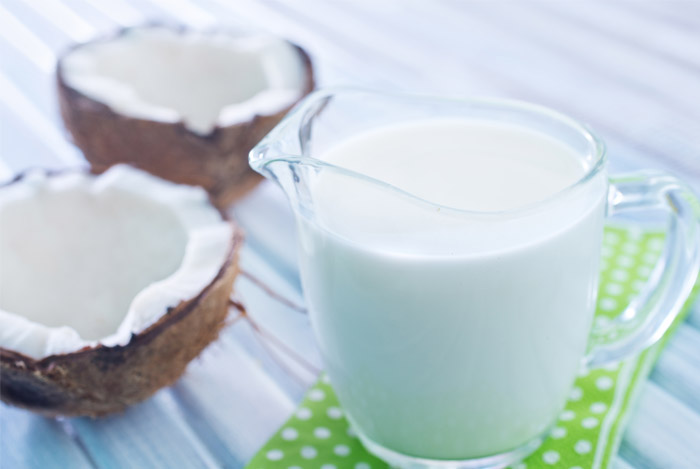 Coconut products are definitely all-the-rage right now. Coconut water and coconut oil are both experiencing huge renaissances, even though they’ve been around for as long as island peoples have enjoyed their taste and benefits.
Coconut products are definitely all-the-rage right now. Coconut water and coconut oil are both experiencing huge renaissances, even though they’ve been around for as long as island peoples have enjoyed their taste and benefits.
Coconut milk is not high in calories like other milks, but it does have a considerable amount of saturated fat in every serving – much more (4 grams) than soy milk, but relatively the same as dairy.
Coconut milk isn’t really the sort of beverage often served up in a glass, it’s mostly used as a creamer/sweetener, or added to cooking for flavor and consistency.
Rice Milk
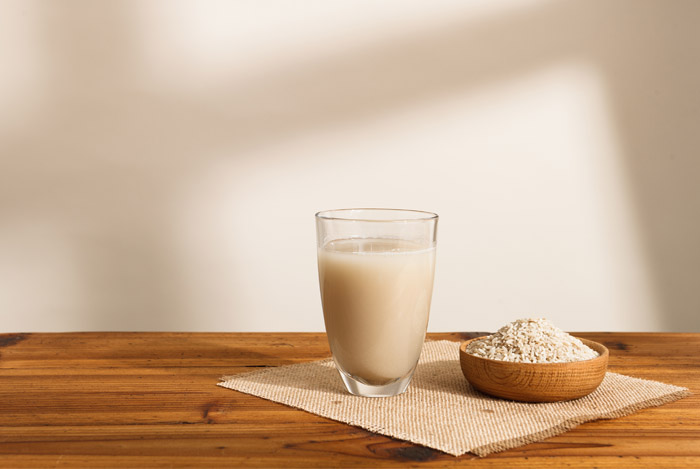 Made by blending rice with water, rice milk is perfect for people who have allergies. It’s relatively rare for someone to have an allergic reaction to rice, making it the right choice for people worried about the likelihood of an allergy trigger.
Made by blending rice with water, rice milk is perfect for people who have allergies. It’s relatively rare for someone to have an allergic reaction to rice, making it the right choice for people worried about the likelihood of an allergy trigger.
Unlike other milks, rice milk contains no saturated fat, but has a similar calorie count (120 calories) and sugar level (10 grams) to dairy milk.
It also doesn’t contain as much protein or calcium as dairy milk. But, it’s much better for your heart, as it has neither lactose nor cholesterol.
Goat’s Milk
 Goat’s milk really isn’t something you run into very commonly on American shelves, but it’s always maintained a healthy popularity worldwide.
Goat’s milk really isn’t something you run into very commonly on American shelves, but it’s always maintained a healthy popularity worldwide.
With 168 calories per serving, 10 grams of total fat with a slightly higher amount of saturated fat than dairy milk, 9 grams of protein, 11 grams of sugar, and equivalent calcium, goat’s milk is better in some areas and worse in others.
There is less lactose in goat’s milk, which may prove easier on more sensitive stomachs. It has more calcium, along with 134 percent more potassium, but only 10 percent of the folic acid of cow’s milk.
Almond Milk
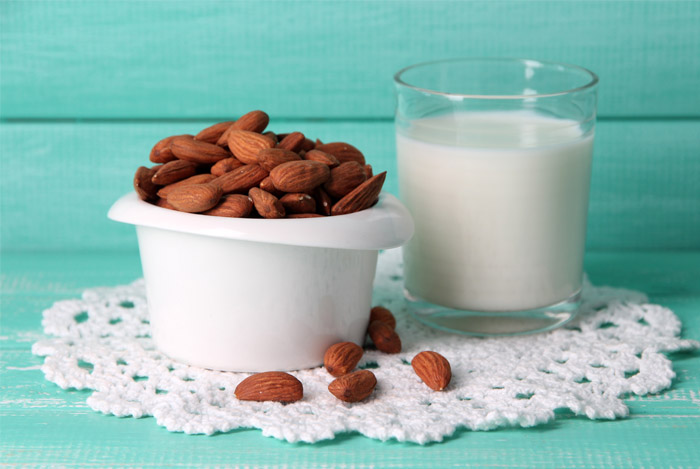 The product of ground almonds and water, almond milk has now seemingly conquered the plant-based milk market. In 2013, industry experts reported that almond milk had taken up a 2/3rds share of the market, destroying rice and soy milk.
The product of ground almonds and water, almond milk has now seemingly conquered the plant-based milk market. In 2013, industry experts reported that almond milk had taken up a 2/3rds share of the market, destroying rice and soy milk.
Regular, sweetened almond milk contains 60 calories per serving, zero saturated fat, 7 grams of sugar, and 1 gram of protein. Unsweetened has only 30 calories per serving.
So, while it’s not a complete substitute for dairy milk, it has some certain health benefits over dairy. It contains a full gram of fiber, B vitamins, and it doesn’t require refrigeration. Some people like the taste more too.
Hemp Milk
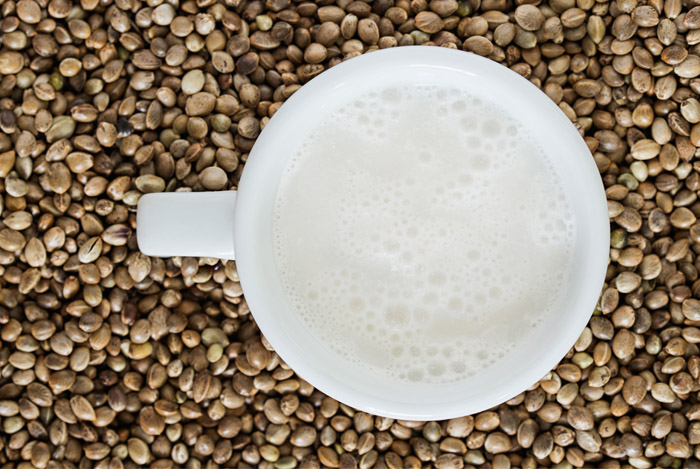 Now, I know what you’re thinking. Hemp milk is probably just some way for college kids to get their fun with their calcium and protein. But that’s not really the case.
Now, I know what you’re thinking. Hemp milk is probably just some way for college kids to get their fun with their calcium and protein. But that’s not really the case.
At 140 calories per serving, 5 grams total fat, only 1 gram of saturated fat, 5 grams of sugar, and 5 grams of protein, this hemp-seed derived milk substitute is interesting.
If you have food allergies, hemp products are not likely to cause any reactions. If you’re a vegan or vegetarian, it’ll work better for you than fat or lactose-free options. It packs a similar amount of calcium to cow’s milk, while providing desirable levels of magnesium, along with B complex vitamins.
And I assure you, there won’t be any questionable side effects.
The Problem With Dairy Milk
There’s now a growing body of evidence demonstrating that traditional dairy milk is bad for your health. Period.
I’ve never been one to advocate drinking it for that reason. I’ve been pretty thoroughly convinced to stay away from it.
Here are some studies to show you what I mean.
Dairy milk is bad for your gut
 People of European descent are really the only group that can handle milk with relative ease. In fact, European Americans are some of the only people who actually enjoy drinking the stuff straight from the glass. Other cultures basically think it’s weird.
People of European descent are really the only group that can handle milk with relative ease. In fact, European Americans are some of the only people who actually enjoy drinking the stuff straight from the glass. Other cultures basically think it’s weird.
A Harvard University School of Public Health study found that 90 percent of Asians, 70 percent of African Americans and Native Americans, and 50 percent of Hispanics are lactose intolerant. Northern Europeans are around 15 percent lactose intolerant.
Altogether, around 60 percent of adults cannot handle the stuff.
Lactose intolerance is a serious problem that can really screw up your digestive tract. It can cause cramping, bloating, gas, and diarrhea.
Another problem with lactose is that you might not even realize it’s causing you problems. Hours after drinking it, when you have gas and bloating, you might associate it with whatever food you ate instead of the tall glass of milk you drank. And as we get older, this only gets worse as our bodies have more and more trouble processing it.
Dairy milk is bad for your skin
 Research reported in the Journal of the American Academy of Dermatology found a link between acne and consuming dairy.
Research reported in the Journal of the American Academy of Dermatology found a link between acne and consuming dairy.
The American Academy of Dermatology now recommend sufferers talk to their dermatologists about their dairy intake in order to ensure better skin in the future.
People who are more likely to have acne, eczema, or other skin conditions should probably stay away from milk – especially skim milk, which has been shown to have the strongest negative effects on skin.
Dairy milk doesn’t actually build strong bones
 There’s no denying calcium is of critical importance to our skeletal structure. Nor can I deny that dairy milk has the highest concentration of calcium per serving of just about any food.
There’s no denying calcium is of critical importance to our skeletal structure. Nor can I deny that dairy milk has the highest concentration of calcium per serving of just about any food.
But studies are now suggesting that the amount of calcium in milk is too much for our bodies. The amount of calcium found in milk may actually increase the risk of hip fractures.
Experts are now even questioning the recommended dietary allowance (RDA) of calcium as put forth by the USDA.
Dairy milk makes you fat
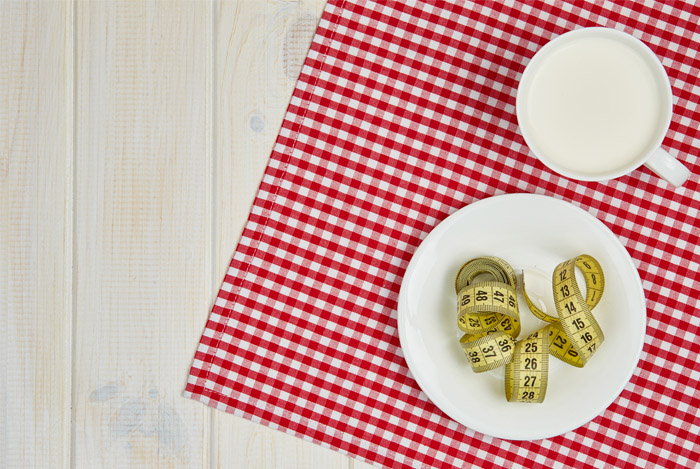 Like I mentioned earlier, dairy milk is high in saturated fat (5 grams per cup). So, what people have done to try and counteract the risk of gaining weight while still drinking milk is switching to skim milk.
Like I mentioned earlier, dairy milk is high in saturated fat (5 grams per cup). So, what people have done to try and counteract the risk of gaining weight while still drinking milk is switching to skim milk.
A Swedish study on nearly 20,000 women found that those who drank skim or 1 percent actually gained more weight than those who drank whole milk.
So, either way you go, drinking dairy milk is likely going to cause harm for your body and your diet.
So What Milk is Healthiest?
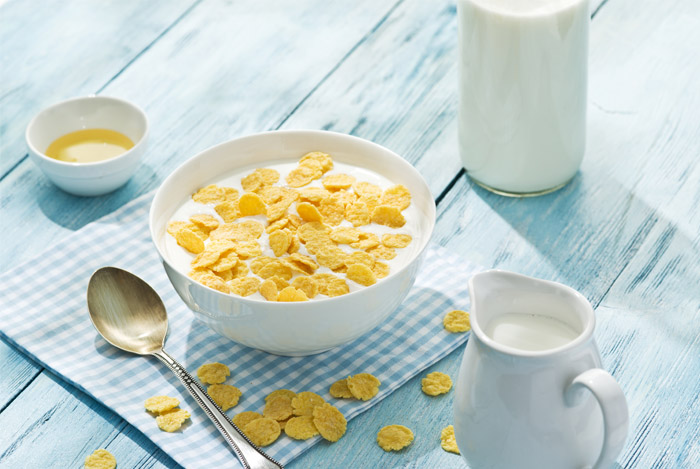 By now you can probably see I’m no fan of dairy milk. So aside from the junk from the cow, after all my research, which alternative milk do I think is the best to drink?
By now you can probably see I’m no fan of dairy milk. So aside from the junk from the cow, after all my research, which alternative milk do I think is the best to drink?
As with so many other choices, it depends.
If you absolutely must have something to splash on your bowl of (whole grain) cereal or mix it into your coffee, an absolute winner is not entirely clear cut.
While unsweetened almond milk certainly has the lowest calorie count of any of the types of milk mentioned, it’s sorely lacking in protein. If you feel your diet contains plenty of protein as is, by all means, go for it, but I still won’t crown it the victor.
If you’re already on a diet and exercise regimen and think you could use the calcium and vitamin benefits present in most of these milks, but aren’t worried about the calories, for you it’ll all come down to flavor.
Slate actually put on a taste test of different varieties of milk and came to the conclusion that lactose-free milk tasted the best, even better than plain milk. But, because it’s still dairy, I won’t give it my seal of approval.
The problem a lot of the milk substitutes have when it comes to flavor is that because they’re trying to emulate the way dairy tastes, they often have to make up for it with loads of sugar. So, once you decide on which substitute you like best, always go for the unsweetened option.
If you’re concerned about weight loss, unsweetened soy may be a better option for you, given its relatively low calorie count and complete lack of sugar and saturated fat, while still packing the protein punch to help keep you full.
At the end of the day, the smartest choice for you to make when it comes to drinking milk or a milk alternative is to go with what’s best for you. Try the alternatives out one by one, or even side by side if you can manage, and decide which has the best flavor and consistency.
Where you would normally drink dairy milk with a certain meal, try one of the others instead. The process of elimination based on your personal preferences, cross-referenced with a proper inspection of nutrition labels, should provide you with the optimal choice.
Your dairy aisle probably contains far more options than the ones I listed here, so if you must have your milk, keep looking until you find what’s right for you. As always, be careful with what you put in your body. Do your research. Be a wise consumer.
And wear your milk mustache proud. If you must.
What are your favorite alternatives to traditional milk?
The post Why I Never Recommend Dairy Milk and Which Milk You Should Drink Instead appeared first on Nutrition Secrets.
http://www.nutritionsecrets.com/dairy-milk/
No comments:
Post a Comment